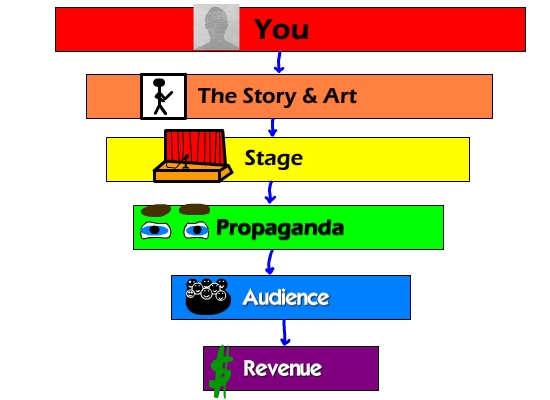Last week I asked my twitter followers to share with me the webComics they were reading and/or creating. The response was amazing and I still haven’t had a chance to visit them all, but the experience got me thinking about what makes a great webcomic.
A lot of new WebComic Creator thinks that if they make a comic and share it with a couple friends that it’ll get passed around & “TA-DA..!”, everyone will know about it and stardom ensues. Those of you that have been creating art online for a while are thinking, “I wish that’s how it went”, but we all know that there is a lot more involved.
In this article I will share with you the elements needed for you to not only create a successful WebComic, but to make an income from it as well.
Let’s get started….
There are 6 elements that make up a successful, engaging, webComic. They are (from most to least important): You (the creator/s), the story & art, the stage, propaganda, audience, & revenue. 
1: You
You are the face of your WebComic and therefore the most important of all the elements, kind of like Hydrogen. Think of your favorite online web series, comic, or podcast. Now think about the person behind it.
Examples are Matt Groening of the Simpsons and Futurama, The Brothers Chaps of Homestar Runner, and Nina Paley of Sita sings the blues.
These are all people who, if you like their work, you may know a lot about. Things I know about these examples:
Matt Groening: Played a lot of D&D as a kid. Got his start from a self-published comic called “Life in Hell” while trying to make it as a writer in Hollywood.
The Brothers Chaps: Played a lot of video games, especially those of the Nintendo franchise. They created the first Home Starr Runner as a children’s book they published 12 copies at a Kikos.
Nina Paley: Had a nasty divorce and then created Sita Sings the Blues. She is a big promoter of the free culture movement (dealing with copyright laws).
These are just things I just know about these creators. I love their work and, in turn, I want to know more about them.
The same is going to happen to you. People don’t just want the art anymore; they want the people behind the art. People might come to visit your webcomic, but they are going to buy from, donate to, or interact on your site because of you.
This doesn’t mean you need to create a new persona (although you could). Instead you might consider using your personal social media accounts to promote your work and connect with other artists, bloggers, and website owners.
2: the story & art
This covers the actual webcomic itself. I am not going to go too deep into this one because I assume that you either already are making webcomics or have a webcomic in mind already.
Basically you have to have a WebComic that is enjoyable and interesting for it to be successful. I will cover issues relating to creating an amazing webComic in future posts.
3: the stage
The stage is where you present your webComic to the world. It can be on your own blog, a third party website, or even just on social media. It is important to get your “stage” to fit and compliment your comic.
My comic is closer to a comic book than to a comic strip, so I have chosen a web design that gives a feel of flipping through pages. I currently have where you can only see one page at a time, but hope to allow for people to view a two page spread soon since the art design was created for a physical comic book.
You also need to take into consideration that many people are switching to mobile devices which can be a pain. My own site struggles on smart phones because you have to swipe to get to the next page, which can cause it to jump 2 pages instead of one.
My friend on twitter Anita Sølver (@soelver or her website at www.soelver.dk) gave me the best advice:
It’s a struggle to try to fit everything with one design. It will always look best on one platform/screensize. Use Google Analytics to find out what people use to access your site, and design for them first. Make it work for the rest 🙂

[…] This post is part 2, you can read part 1 here. […]